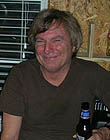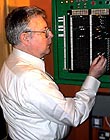|
|
 
|
|
Author
|
Topic: Timecode on NTSC.
|
|
|
|
|
|
|
Mark Ogden
Jedi Master Film Handler
Posts: 943
From: Little Falls, N.J.
Registered: Jun 99
|
 posted 07-24-2005 10:31 AM
posted 07-24-2005 10:31 AM




NTSC, and all US broadcasting, utilizes what's called "drop-frame" time code, but that's actually an inaccurate name as no frames are dropped, just their TC numbers. What happens is that at the top of every minute of running time code, the first two frames have no count (for instance, the first counted frame after TC 1:00:02:29 would be 1:00:03:02). This holds true except when the minutes are multiples of 10 (20, 30, 40 and so on) when each frame has a valid TC. Somehow it all pans out math-wise in the end.
You can also stripe non-drop frame, but because of the fractional NTSC frame rate you will not wind up with an accurate duration at the end of a long program. This is OK for a shorter length item, but you'll wind up with an unaccounted-for 54 frames or so at the end or an hour program.
[ 07-24-2005, 02:19 PM: Message edited by: Mark Ogden ]
| IP: Logged
|
|
|
|
|
|
Stephen Furley
Film God

Posts: 3059
From: Coulsdon, Croydon, England
Registered: May 2002
|
 posted 07-24-2005 11:19 AM
posted 07-24-2005 11:19 AM




quote: Andy Summers
Strange I though it was 25fps 1sec for PAL and 24fps 1sec for NTSC, no mater if I can see the image fine.
PAL is 25 frames per second and NTSC is 29.97. These frame fates are laid down in the standards for the video systems and do not change. Film is usually 24 frames per second, but other speeds are sometimes used for special purposes. You can run film at any speed you like up to the point where either the film itself or the camera mechanism is damaged. Fairly conventonal camera mechanisms can run at over a hundred frames per second, special ones with a rotating prism and continuously moving film can manage several thousand. If only the television people had adopted one standard world-wide film would probably have been altered to match by now, and there would be one standard speed for everything. As it is now, increasing the film speed to 30 would improve things for NTSC transfers, but make them worse for PAL
quote: Andy Summers
As for the image on “FAR AND AWAY” I ran the DVD Region 2 version and noticed the frame area on the Laserdisc had more height too it, and far less on the DVD, however noticed just a little bit more width on the DVD.
Video transfers are not always accurately made; you quite often see less, or more, than you were intended to in either direction.
| IP: Logged
|
|
|
|
|
|
|
|
Bruce Hansen
Jedi Master Film Handler

Posts: 847
From: Stone Mountain, GA, USA
Registered: Dec 1999
|
 posted 07-25-2005 11:47 AM
posted 07-25-2005 11:47 AM




The reason for the different frame (or field) rates has to do with power line frequency. The power in places like England is 50 Hz, here in the US it is 60 Hz. The field rate was made the same as the power frequency so that any small amount of power "hum" that ended up in the picture would not be moving through the picture, and not be noticeable. Of course, when we added color here in the US, the scanning rates were changed slightly, so that everything would be coherent with the color sub carrier, and that gave us a 59.94 vertical rate. Now you will see hum as dark and light bands moving slowly up the screen, but equipment is better than it was years ago, so the hum problem is not much of a problem any more.
Non-drop frame code is OK for something where you are not concerned about knowing the exact running time, and can be easier to edit with. If you are editing something for broadcast, you should use drop frame. Most edit systems today can handle the two types of code, and even intermix them.
| IP: Logged
|
|
|
|
All times are Central (GMT -6:00)
|
|
Powered by Infopop Corporation
UBB.classicTM
6.3.1.2
The Film-Tech Forums are designed for various members related to the cinema industry to express their opinions, viewpoints and testimonials on various products, services and events based upon speculation, personal knowledge and factual information through use, therefore all views represented here allow no liability upon the publishers of this web site and the owners of said views assume no liability for any ill will resulting from these postings. The posts made here are for educational as well as entertainment purposes and as such anyone viewing this portion of the website must accept these views as statements of the author of that opinion
and agrees to release the authors from any and all liability.
|

 Home
Home
 Products
Products
 Store
Store
 Forum
Forum
 Warehouse
Warehouse
 Contact Us
Contact Us




 Printer-friendly view of this topic
Printer-friendly view of this topic













